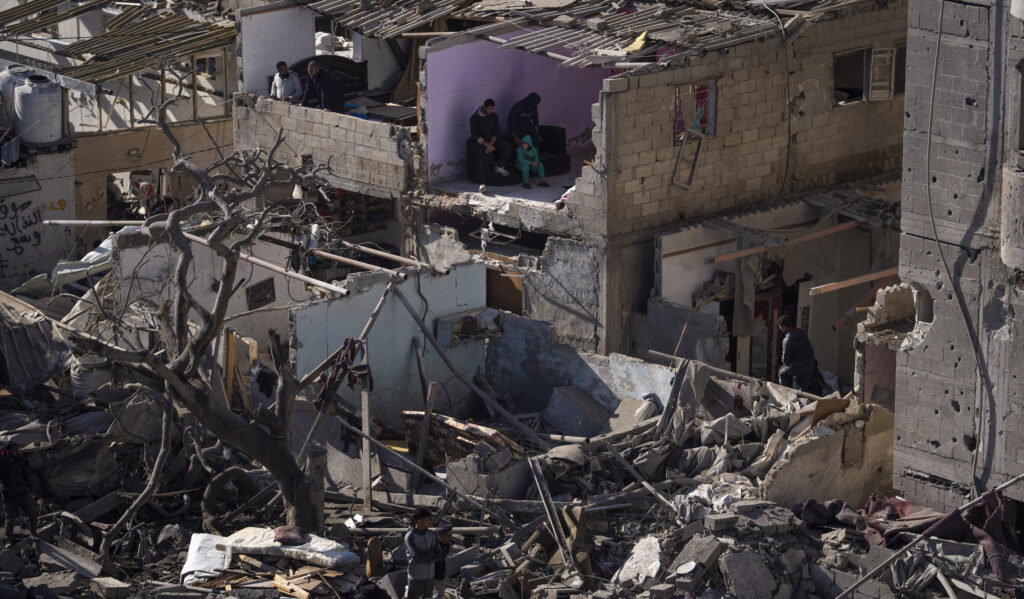Satellite imagery analyzed by the United Nations shows that roughly 35% of all buildings in the Gaza Strip have been damaged during the Israel–Hamas war, while more than 10% have been destroyed.
The United Nations Satellite Center released an update on Wednesday regarding the destruction caused by nearly six months of war in the enclave. It found that 88,868 buildings have either been destroyed, severely damaged, or moderately damaged, and this represents a nearly 20,000 increase since the previous assessment in January.
Its statistics indicate there are nearly 254,000 buildings within the entire strip.
It found that nearly 31,200 buildings were destroyed, or approximately 12%; nearly 17,000 were severely damaged, or approximately 7%; and more than 40,700 buildings were moderately damaged, about 16%.
Much of the new damage has come in Khan Yunis, one of the primary locations where Israel has carried out large-scale operations against Hamas this year.
The imagery experts analyzed came from Feb. 29, 2024, and they compared it with other images from May 1, 2023; May 10, 2023; Sept. 18, 2023; Oct. 15, 2023; Nov. 7, 2023; Nov. 26, 2023; Jan. 6, 2024; and Jan. 7, 2024.

Israel’s military operation in Gaza has also resulted in the deaths of nearly 32,000 Palestinians, according to the Gaza Health Ministry, which is controlled by Hamas and does not differentiate between civilians and combatants. Hamas, the terrorist group that prompted this war with the Oct. 7 terrorist attack in southern Israel, intentionally embeds itself within civilian groups, and it spent years and billions of dollars building an extensive tunnel system underneath the densest areas of the strip.
The significant destruction of the infrastructure represents a problem for what happens once the war is over and when Israeli forces allow Palestinians to return to the northern parts of the strip.
Israeli forces began their operations in the northern part of the strip and urged civilians to move south. Then, as Israel’s operations began migrating to the central part of Gaza, Israel encouraged Palestinians to travel further south to avoid the primary areas of combat. As a result, there are now more than a million Palestinians who have left their homes to seek refuge in Rafah, the southernmost city in the enclave, with significant destruction awaiting their return north.
Israeli leaders maintain they have to carry out significant operations in Rafah, while the United States and many other Western nations have urged them not to due to their concerns about the potential for a significant number of civilian casualties. Israeli officials have not shared how they plan to account for those civilians to their U.S. counterparts.
Israeli Prime Minister Benjamin Netanyahu agreed to send a delegation to Washington, D.C., to hear the administration’s alternative strategy proposals.
They have left areas in the northern part of Gaza after completing operations there, which has led to various problems. It is very difficult for humanitarian organizations to get to northern Gaza due to lawlessness. With Israel’s military leaving a power void in the northern part of the strip, that area has descended into “anarchy,” U.S. national security adviser Jake Sullivan told reporters earlier this week.
Israeli forces went back to the Shifa Hospital in northern Gaza this week and have engaged in days of combat against militants. The Israel Defense Forces said on Thursday that more than 140 militants have been killed in this operation at the hospital while approximately 600 more have been apprehended.
“The IDF is operating and will continue to operate wherever Hamas is active in order to dismantle Hamas military and administrative capabilities,” an IDF spokesperson told the Washington Examiner. “This is in response to Hamas’s barbaric attacks.”
Israeli leaders said they want the next governing body of the area to be an entity that is willing to live side-by-side with them, but figuring out who that may be is unclear. The U.S. has floated the idea that a resurgent Palestinian Authority should govern the West Bank and Gaza, but Israel’s government has spoken out against that.
Israel is hoping to find Palestinian leaders it can enlist in the distribution of humanitarian aid into Gaza that cuts out Hamas, which has angered the terrorist group.
CLICK HERE TO READ MORE FROM THE WASHINGTON EXAMINER
“Accepting communication with the occupation forces by heads of families and tribes for work in the Gaza Strip is considered national betrayal, which we will not allow,” a Hamas security official said in a public statement on March 10.
Netanyahu reportedly opposes the inclusion of the Palestinian Authority’s top intelligence official, Majid Faraj, and Mohammed Dahlan, a former senior member of Fatah, according to the Wall Street Journal. Dahlan has said he doesn’t want to be involved in running Gaza, but he also doubted that there could be a governing body without Hamas.
